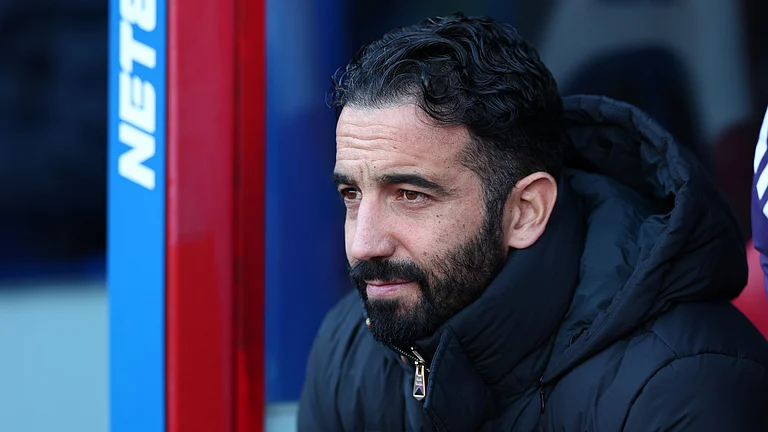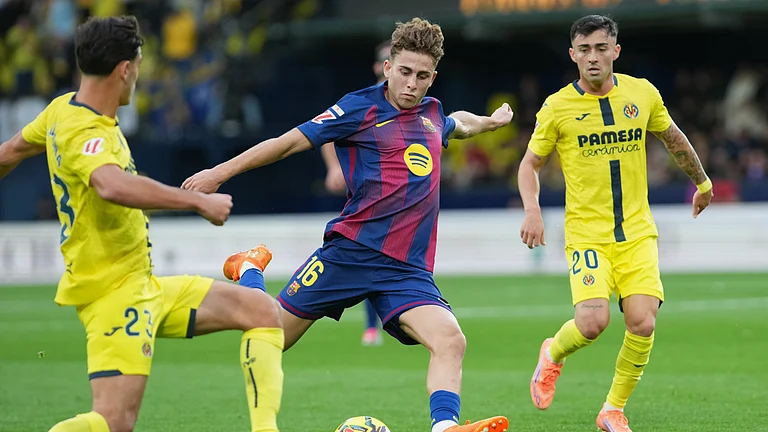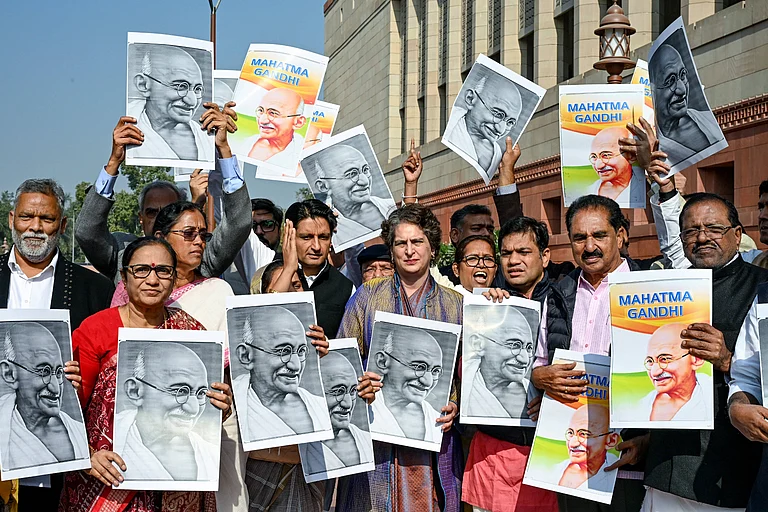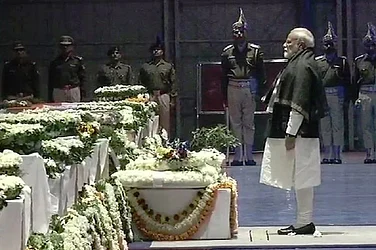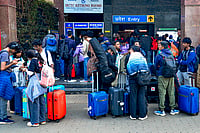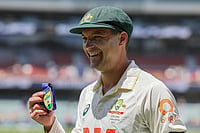In his FIR, Balkaur mentioned one name—Lawrence Bishnoi. His suspicion was based on the many threatening phone calls Moosewala had received from Bishnoi’s gang. But then there were others too. Sidhu had entered into open arguments and confrontations with people on social media. Some of these people were also singers and, according to father and son, motivated by jealousy. There was also the possibility that Moosewala’s political rivals had eliminated him.
About three-and-a-half hours after the murder, without any arrests or substantial evidence, the head of the Punjab Police, DGP V.K. Bhawra, the man who led some 80,000 police personnel, said the murder was due to an ongoing war between different gangs in Punjab. Balkaur Singh contested the claim. It was only the second month of the newly-formed Aam Aadmi Party’s government in Punjab, and all departments were under pressure to perform or respond swiftly to any exigency. Bhawra seemed to be trying to control public anger about the murder by announcing that the police were going to catch the killers as soon as the motive was clear.
Angry fans of the singer had already crowded Mansa Civil Hospital, shouting slogans and demanding justice. The police also claimed that the Bishnoi gang had killed Moosewala to avenge the killing of gangster-turned-politician Vicky Middukhera, who was killed on 7 August 2021.
The ‘swift’ police investigation was based on a Facebook post by one Goldy Brar, an A-listed, wanted gangster said to be hiding in Canada, and a key aide of Lawrence Bishnoi. In the post, Goldy Brar claimed the responsibility for the killing of Moosewala. ‘I, Goldy Brar, assert here that I, along with Lawrence Bishnoi and Sachin Bishnoi, have got singer Sidhu Moosewala killed. He was killed because he played a big role in the murder of our brothers Vicky Middukhera and Gurlal Brar.’
Sitting next to his son’s body lying motionless on a stretcher in the civil hospital, Balkaur desperately needed some consolation, some answers, some hope. ‘It is not just a crime against us but against the state,’ he wailed.
Balkaur didn’t believe that his son was involved in any man’s killing. He criticised the insensitivity of the Punjab DGP and the state government for calling his son a gangster. The DGP apologised the next day, and so did the chief minister of Punjab. But the questions on the killing remained.
‘Lawrence Bishnoi will have all the answers. Police should question him first before jumping to conclusions. My son was killed by gangsters as he refused to toe the line drawn by them, not because of a gang war!’ Balkaur Sidhu shouted in agony at reporters who pressed him for a response to statements made by the police.
Before Lawrence Bishnoi became a household name, making regular appearances in the news for his nefarious exploits, India had been familiar with the Bishnoi community for very different reasons. Followers of the fifteenth-century saint, Shri Jambeshwarji, the Bishnois are known to be staunch wildlife conservationists. They live by twenty-nine principles (their name is a derivative, the ‘bees-noi’), all of which are geared towards peaceful and harmonious living with nature. Not only are the Bishnois strict vegetarians, they are also forbidden from killing animals even in self-defence. For the Bishnois, wildlife is sacred and they protect it at all costs. Even dry deadwood is not burnt without carefully examining it for traces of any living organism that may have made it its home.
The Bishnois garnered national attention when in 1998, members of the community gave chase to actor Salman Khan when he was out for a hunt on their protected land, while on the outdoor location for the shoot of the movie Hum Saath-Saath Hain. The actor and some of his friends, also from the film industry, were reported for the shooting of chinkaras and blackbucks. In the long legal battle that ensued, several witnesses turned hostile or went missing. However, two eyewitnesses, Poonam Chand Bishnoi and Chogaram Bishnoi, residents of the village of Kankani at Bagdonki Dhaani, steadfastly stood by their statements against Khan, leading to his conviction. More than twenty years have passed since the incident and Khan is out on bail, but the community continues to pursue the case against the superstar and wants him to be punished for what they perceive to be sacrilege.
Standing up to protect the environment is an integral part of being a Bishnoi. It is said that in 1730, as many as 363 Bishnois, led by Amrita Devi, laid down their lives to protect a grove of Khejri trees in village of Khejarli, in modern-day Jodhpur district, from the Mewar army. This brave act has been a major influence on the modern-day Chipko movement.
Today, Bishnois are settled across Punjab, Rajasthan and Haryana. A larger concentration of the community is in the Fazilka district of Punjab, with Abohar being the main town. The Abohar Wildlife Sanctuary, at the centre of this belt, is a safe haven for the Bishnois’ sacred blackbuck. At the edge of this sanctuary is village of Duttranwali, where Lawrence Bishnoi was born on 12 February 1992.
--
Just about five-and-a-half feet tall but sturdy in build, Lawrence has the looks of a film star. As per the profile dossiers on him made by the police teams of Punjab, Haryana, Rajasthan and Delhi, Lawrence is fastidious about his workout. His biceps and triceps, deltoids, trapezius and dorsal muscles appear well-defined over a broad wrestler’s chest. He follows a strict free-weight exercise regimen besides working out with bodyweights in the akhara. The dossiers say Lawrence is a Brahmachari who mostly wears a langot and spends up to eight hours in dhyan or meditation. Sometimes, it was said, he would sit in meditation in his cell in Tihar Jail at midnight and get up well past sunrise. Some police officials say, on the condition of anonymity, that his deep-set eyes have the ability to scan a person thoroughly with just one look.
Why did this fresh-faced and charismatic youth turn to a world of crime? Well, it certainly wasn’t for money. Lawrence’s family is one of the wealthiest in the village. They live in a big haveli and own about 110 acres of land. His father, Lavinder Singh, did not study beyond class 8 and was happy managing the land. His mother, Sunita, a resident of the village of Jyotanwali near Dabwali in Haryana, was a homemaker despite being a graduate. Lavinder and Sunita had two sons, the elder one was called Lawrence and the younger, Anmol.
Both are prime accused in the Moosewala murder case.
--
Before his name appeared in the Moosewala case, Lawrence had already been in the news. In January, 2018, he was produced in a Jodhpur court by the police for a case of extortion and for making death threats to Salman Khan. He announced to the waiting media, ‘Salman Khan will be killed here, in Jodhpur … Then he will come to know about our real identity.’
Six months later, on 6 June, Lawrence’s close aide Sampat Nehra was arrested by the Haryana Police. On being interrogated, he told the police that he had conducted a recce of Salman Khan’s house, followed his movements and clicked several photos of the actor. Nehra said he was following Lawrence Bishnoi’s directions. His task was to eliminate Salman for the blackbuck killings.
There is no doubt that in just a few years, Lawrence had emerged as a powerful gangster who could openly threaten even big stars like Khan. Fifty-two-year-old Ramesh Bishnoi, who is related to Lawrence’s extended family, claims the police have painted him as a monster, which he is not.
President of the All India Jeev Raksha Bishnoi Sabha, Ramesh was forthcoming while speaking about Lawrence. Though Lawrence and he had more than twenty years between them, they were ‘dada-bhai’, said Ramesh. ‘My grandfather and Lawrence’s grandfather were brothers. Lawrence[’s] family is the wealthiest …But both their sons are facing criminal cases and there does not seem to be a way back now,’ he lamented.
Ramesh further spoke about how Lawrence’s unusual first name had been chosen by his mother, Sunita. He was named after Henry Montgomery Lawrence, the British military officer who set up the famous Lawrence School in Sanawar. ‘Lawrence she called him as he was pinkish-white like the British … she hoped her son would become a big name like Henry Lawrence, who had set up the school on the hills in Himachal Pradesh, strictly for the elite and classy,’ Ramesh reminisced.
While his mother may have nurtured such dreams, the son turned out to be a nightmare for many. He set up a chain of gangs and left a trail of blood wherever he went.
From Ramesh’s account and by reading police dossiers of different states, one can piece together the life of Lawrence Bishnoi before he burst on the scene as a hardened criminal. He studied till class 12 in a convent school in Abohar, about 9 km from his village. Lawrence was a good student and had, at one time, even earned a scholarship, not that he needed one. Ramesh reveals, ‘Lawrence used to go in a van to the school with other kids but after class 8, he went on his own bike. And he loved branded clothes. It was no big deal for him to wear shoes worth more than Rs 10,000. He still maintains that style. Also, he used to help children of poor families in the village. It was common for him to bring the needy home, asking his parents to help. He was an introverted guy but he always had a following in the village and the school.’
After finishing school in 2008, Lawrence attended DAV College, Chandigarh, where he took a fancy to student politics.
‘Lawrence had money, style and guts. It was easy for him to get followers among students, many of whom could not afford his lifestyle. Perhaps egged on by followers, he joined SOPU—Student Organisation for Panjab University—in the very first year of college,’ a Chandigarh police DSP, who had arrested Lawrence after a college brawl revealed. The DAV College was affiliated to Panjab University. Every year, in September–October, elections to student organisations in the college and the university would take place. Lawrence contested these elections in 2009 but lost. It appears the loss did not go down well with the young student leader. ‘Maybe he was not used to opposition, or it could be mere misfortune that he got involved in brawls over the student elections,’ recollects another police officer who had questioned Lawrence in his first case.
Trusted sources in the police say that, according to police dossiers, Lawrence moved in the company of former student leaders Jaswinder Singh Rocky, Vicky Middukhera, Goldy Brar and Sampat Nehra (whom Lawrence later tasked with killing Salman Khan) in college. These people had a major impact on his life. Ultimately, the early connections that Lawrence forged made him who he is and perhaps even led to the killing of Sidhu Moosewala.
After losing the elections, Lawrence and members of the SOPU had regular heated exchanges. Ugly brawls became common and it is alleged that Lawrence once set a rival’s car on fire in anger. In April 2010, after another such exchange, Lawrence and his friends were arrested. However, these fights seemed to strengthen his public standing, for in the next session, Lawrence was appointed the head of the SOPU. His strongman image was further consolidated when, in October 2010, Lawrence and his friends opened fire at yet another brawl.
Amongst all the connections Lawrence Bishnoi made during his time in Punjab student politics, his friendship with Vicky Middukhera was perhaps the strongest. The soft-spoken and unassuming Middukhera had taken young Lawrence under his wing and helped him establish his position in Chandigarh student politics. Over the years, their friendship grew so strong that Bishnoi considered Middukhera his elder brother. Vicky Middukhera would go on to become a leader of the Youth Akali Dal, while Lawrence’s name gradually started gaining more importance in the underworld. His time in jail rewarded him with more criminal connections and that, coupled with his daring nature, led him to embrace a brazen life of crime. Today, he has fifty-nine criminal cases against him in Punjab, Haryana, Rajasthan and New Delhi.
In the biggest of these cases, Delhi Police slapped the stringent Maharashtra Control of Organised Crime Act, 1999 (MCOCA) on Lawrence and his gangster friend, Jaggu Bhagwanpuria. The MCOCA, as the name suggests, was enacted by the Maharashtra government to combat gangs and mafia that mushroomed in the state, and especially in Mumbai. The Act allows the imprisonment of gangsters and mafia men, who are recognised as dangerous to society, without trial for up to 180 days, unlike the standard 24 hours. The Act also provisions that confessions before a police officer are admissible before a court of law.
The Ministry of Home Affairs adopted MCOCA in February 2002. Punjab had similar plans but the state’s political parties have not agreed to its implementation yet. Lawrence was booked under MCOCA in 2021, in Delhi, after he established a syndicate, along with gangsters and shooters of Delhi NCR (National Capital Region), which includes Noida, Gurgaon, Faridabad and Ghaziabad. The syndicate also had connections and influence in other areas in the states of Haryana, Rajasthan and Uttar Pradesh. It grew in power through networking and by cultivating supporters, sympathisers and followers across the country.
--
On 29 May, at about 6.30 p.m., a mobile phone rang in Delhi’s Tihar Jail. The phone belonged to Lawrence’s coinmate, a gangster from New Delhi. The call was made through the Signal app, as police later discovered.
Sixty-four days later, the conversation that took place that day came to light after it was ‘leaked’ to the press.

THE CALL
The phone rings three times and is then answered.
Caller: Hello.
Receiver: Hello.
Caller: Hello.
Receiver: Hello. Hanji. Ji.
Caller: Mmmmm. Baat ho sakti hai? (Is it possible to speak?)
Receiver: Haan. Bilkul ho sakti hai. (Yes, of course, why not.)
Caller: Karwana. Zaruri hai. (Please connect us. It is important.)
Receiver: Hanji. Ek minute. (Yes. Just a moment.)
Caller: Haanji. Thoda zaruri hai. Aise hi rakhein. (Yes. It’s a bit important. Don’t disconnect.)
Receiver: Haan. Line te rahi. Hold kari. (Stay on the line and hold.)
A twenty-seven-second-long pause follows, during which footsteps and breathing can be heard. It seems the person holding the mobile phone is walking towards someone. When a voice is heard again, it is someone else.
Police say it was Lawrence who took over the call.
Receiver: Hello?
Caller: (Inaudible. Says something like a salute to the Gurus, then continues.) Speaker on taan ni? Meri gal sun. Mubarakan bahot, bahot bhra nu. Giani charra ta gaddi. (I hope the speaker is not on. Listen to me. Many congratulations to you, my brother. Giani has been mowed down.)
Lawrence: Ki?
Caller: Giani charra ta gaddi
Lawrence: Hein?
Caller: Giani charra ta gaddi.
Lawrence: Ki karta! (What are you saying?)
Caller: Oh, Giani charra ta gaddi. Moosewala maar ta. (Giani has been mowed down. Moosewala is dead.)
Lawrence: Changa.
Caller: Hmm … Ji
Lawrence: Maarta?
Caller: Haan, haan … hmmm
Lawrence: Ok. Cut de.
--
An hour after Moosewala’s death, Bishnoi’s key aide Goldy Brar wrote a post on Facebook, claiming responsibility for the murder. The post went viral worldwide – the dubious fame every gangster craves. A day later, the Punjab Police issued a look-out notice against Brar, who, according to their records, was hiding somewhere in Canada. They informed the Ministry of Home Affairs to initiate the extradition procedure with the Canadian government for the gangster’s return to India. So far, Brar has not returned.
Extracted with permission from Who Killed Moosewala? By Jupinderjit Singh published by Westland Non-Fiction, an imprint of Westland Books







